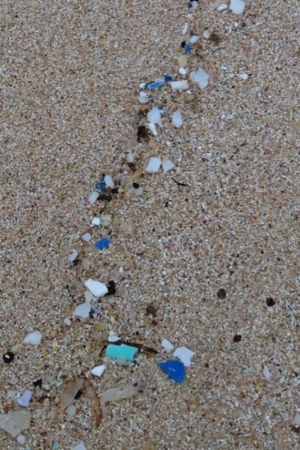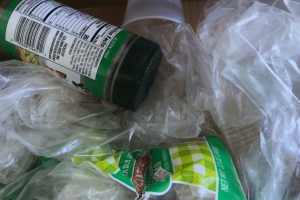The ubiquity of plastics made its greatest impression on me five years ago on a visit to Easter Island. Twenty-one hundred miles west of mainland Chile, it is one of the most remote inhabited places on earth.
As my husband and I strolled a beach on the northeast shore, we were intrigued and then aghast at the multi-colored sand. Every inch included a rainbow of microplastics that had surfed in from somewhere far away.

I try not to dwell on collective guilt for all this pollution. Plastics are also the source of phenomenal improvements in products from prosthetic limbs to lightweight (and therefore energy efficient) aircraft components. It’s a matter of using fossil fuel-based products for their highest use and not for mere convenience.
“Plastic has become its own crisis, contributing to climate change,” charges Kathi King, the Community Environmental Council’s (CEC) director of outreach and education. “Plastic is durable enough to last for hundreds of years, yet more than half of all the plastic we produce is used only once and discarded within a few minutes.”
In a July 8 webinar, the CEC and Channelkeeper described to stakeholders (that’s all of us) how they’ve worked to reduce the Central Coast’s dependence on single-use plastic. They focused on the connections between health and plastic in a time when the plastics’ industry is using the pandemic crisis to roll back regulations on packaging.
More marine woes: Scientists in Ireland found that three-fourths of a sample of 233 deep-sea fish in the Northwest Atlantic Ocean contained microplastics. Moreover, a 2016 World Economic Forum report postulated that in weight there will be more plastic in the sea than fish by 2050.
You can join their July 29 webinar for what surely will be another enlightening as well as inspiring take on the situation.
Accounting for plastic’s whole life cycle hasn’t come easily to most of us alive now. Until the post-war economic — and plastics — boom, durable goods were cared for, repaired and rarely replaced. Food was grown dearly, eaten fresh or preserved, or fed to the animals if overripe. Plastics have rewritten the laws of consumption.
Plastic Free July (PFJ), endorsed by the city of Santa Barbara, the CEC and others, advocates actions that are within each of our reach. PFJ helps us figure out small life-style changes to reduce the amount of plastics in our landfills, oceans and wildlife.
I perused My Challenge Choices and found the guidance broad enough that most could feel good about actions they’re already taking while pinpointing aspirational goals.
Recycling has been more difficult since developing countries started refusing our recyclables. The situation is a lot worse in COVID times.

My old goal was increasing the ratio of recycling to trash; I’ve reframed that to avoiding as much plastic packaging as I can. When I’m at a grocery that cleans its carts, I pile in produce without grabbing a plastic bag for each. Then I quarantine them as my usual practice. I line my kitchen garbage with a paper bag, adding a small used plastic bag inside for wet trash.
In my “aspirational” column would be choosing alternatives for products containing microbeads. These tiny plastics are found in clothing, tennis balls, laundry and dishwasher pods, glitter, wet wipes, tea bags, paint, takeout cups, and lots more. Microplastics slip through sewer filtration systems and end up in the ocean.
Also in our sewers and septics is our plastic poop. A British scientist (or likely the scientists’ grad students) found that, “The average daily motion [human feces] contains 200 pieces of microplastics.” Their study concluded that we are ingesting around 73,000 tiny bits of plastic every year in our food and drink.
Join Plastic Free July for your own good gut.

Karen Telleen-Lawton, Noozhawk Columnist
This article was published on July 13th, 2020 in Noozhawk – you can read it “in print” here.
Karen Telleen-Lawton is an eco-writer, sharing information and insights about economics and ecology, finances and the environment. Having recently retired from financial planning and advising, she spends more time exploring the outdoors — and reading and writing about it. The opinions expressed are her own.
KTL at CanyonVoices dot com

